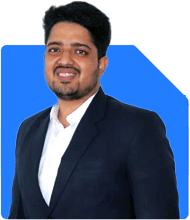Should I Invest My Son's Matured Policy in Corporate Bonds?
Ramalingam Kalirajan |10881 Answers |Ask -Follow
Mutual Funds, Financial Planning Expert - Answered on Sep 02, 2024
He has an MBA in finance from the University of Madras and is a certified financial planner.
He is the director and chief financial planner at Holistic Investment, a Chennai-based firm that offers financial planning and wealth management advice.... more

Recently one of the policies of my son (aged 19 yrs) has matured and I want to invest that 10 lakhs in corporate regular income bonds for a span of 4-5 yrs and use its monthly payouts to invest in mutual funds through SIP. This is to help him with sufficient corpus by the time he is out of his college to complement his job or support him if he wants to start a business. Is this strategy right to utilize the sum of money available? Kindly guide me and also which type of regular income bonds to go for and whether to go for a bouquet of bonds or invest in only one?
Corporate Bonds: A Closer Look
Corporate bonds offer regular income and are considered safer than equity investments. They are ideal for preserving capital while generating steady returns. However, corporate bonds come with risks:
Credit Risk: The company may default on interest payments.
Interest Rate Risk: Bond prices may fall if interest rates rise.
Diversification: A Better Approach
Investing in a single bond can be risky. A better approach is to diversify across multiple bonds:
Different Credit Ratings: Invest in bonds with varying credit ratings to balance risk and return.
Different Sectors: Invest in bonds from different industries to spread sector-specific risks.
Maturity Periods: Choose bonds with different maturity periods to manage liquidity.
Diversifying reduces the impact of a single bond underperforming or defaulting.
Regular Income vs. Growth
Your strategy of using bond payouts to fund SIPs in mutual funds is sound. It provides a regular flow of capital into equity, which has the potential for higher long-term returns. However, consider the following:
Reinvestment Risk: If the bond's interest payments are low, the amount invested in mutual funds may be insufficient to meet your long-term goals.
Market Conditions: Bond yields are influenced by market conditions. Lower interest rates might reduce your payouts.
Inflation Impact: Over 4-5 years, inflation can erode the real value of your bond interest.
Assessing the Duration
You mentioned a 4-5 year horizon for bonds. This timeframe is relatively short for long-term wealth accumulation. Bonds typically perform better over longer durations. If you are looking for growth, a portion of the Rs 10 lakhs could be directly invested in mutual funds or other growth-oriented instruments. This would allow for compounding, which is essential for long-term wealth creation.
Mutual Funds: The Power of SIP
SIPs in mutual funds allow you to benefit from rupee cost averaging. They also enable disciplined investing. However, the effectiveness of your SIPs depends on:
Fund Selection: Actively managed funds can outperform index funds in the long term. Choose funds with a consistent track record.
Investment Horizon: Longer horizons (7-10 years) allow your investments to ride out market volatility.
Portfolio Review: Regularly review and rebalance your portfolio to stay aligned with your financial goals.
The Role of Asset Allocation
Asset allocation is crucial. It’s not just about bonds and mutual funds; it’s about the right mix of equity, debt, and other asset classes. Consider the following:
Equity Exposure: Given your son’s age and the long-term horizon, a higher equity exposure could yield better returns.
Debt Allocation: Corporate bonds can form a part of your debt allocation, providing stability.
Alternative Investments: You might also explore hybrid funds or other conservative instruments that offer a balance between growth and safety.
Liquidity Considerations
Corporate bonds are less liquid than stocks or mutual funds. If you need access to your capital before maturity, you may face penalties or have to sell at a loss. Ensure that the portion of your investments in bonds doesn’t tie up funds you might need for emergencies or other immediate goals.
Tax Implications
Interest from corporate bonds is taxable as per your income slab. SIPs in equity mutual funds, on the other hand, attract long-term capital gains tax after one year, which is more tax-efficient. The tax aspect should be factored into your overall strategy:
Tax-Efficient Bonds: Look for bonds offering tax benefits, if available.
Tax on SIPs: Consider equity-linked savings schemes (ELSS) if you need tax-saving options.
Evaluating Your Financial Goals
Your goal is to provide your son with a substantial corpus by the time he finishes college. To achieve this:
Revisit Goals Regularly: Financial goals can evolve. Revisit and adjust your strategy every year.
Education Fund: If education is a priority, consider a dedicated education plan or child-focused mutual funds.
Business Backup: If there’s a possibility of your son starting a business, ensure that part of the investment is easily accessible and not locked into long-term bonds.
Final Insights
Your strategy is thoughtful but requires careful planning. Diversifying your bond investments is essential. Consider a mix of growth and safety to meet your long-term goals. Regularly review your investments and adjust them based on market conditions and your evolving financial needs.
Best Regards,
K. Ramalingam, MBA, CFP,
Chief Financial Planner,
www.holisticinvestment.in
You may like to see similar questions and answers below
Ajit Mishra | Answer |Ask -Follow
Answered on Apr 01, 2020
Ulhas Joshi |280 Answers |Ask -Follow
Mutual Fund Expert - Answered on Mar 15, 2023
Nikunj Saraf | Answer |Ask -Follow
Mutual Funds Expert - Answered on Aug 08, 2023
Ramalingam Kalirajan |10881 Answers |Ask -Follow
Mutual Funds, Financial Planning Expert - Answered on Apr 12, 2024
Ramalingam Kalirajan |10881 Answers |Ask -Follow
Mutual Funds, Financial Planning Expert - Answered on May 15, 2025
Dr Dipankar Dutta |1841 Answers |Ask -Follow
Tech Careers and Skill Development Expert - Answered on Dec 14, 2025
Nayagam P P |10854 Answers |Ask -Follow
Career Counsellor - Answered on Dec 14, 2025
Radheshyam Zanwar |6744 Answers |Ask -Follow
MHT-CET, IIT-JEE, NEET-UG Expert - Answered on Dec 14, 2025
Radheshyam Zanwar |6744 Answers |Ask -Follow
MHT-CET, IIT-JEE, NEET-UG Expert - Answered on Dec 14, 2025
Dr Dipankar Dutta |1841 Answers |Ask -Follow
Tech Careers and Skill Development Expert - Answered on Dec 14, 2025
Dr Dipankar Dutta |1841 Answers |Ask -Follow
Tech Careers and Skill Development Expert - Answered on Dec 13, 2025
Dr Dipankar Dutta |1841 Answers |Ask -Follow
Tech Careers and Skill Development Expert - Answered on Dec 13, 2025
Mayank Chandel |2575 Answers |Ask -Follow
IIT-JEE, NEET-UG, SAT, CLAT, CA, CS Exam Expert - Answered on Dec 13, 2025
Radheshyam Zanwar |6744 Answers |Ask -Follow
MHT-CET, IIT-JEE, NEET-UG Expert - Answered on Dec 13, 2025
Mayank Chandel |2575 Answers |Ask -Follow
IIT-JEE, NEET-UG, SAT, CLAT, CA, CS Exam Expert - Answered on Dec 13, 2025

























